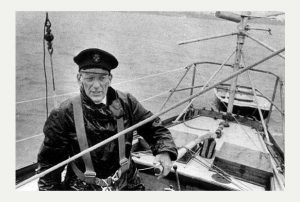Discovery Channel Magazine. Solo feats – Francis Chichester

Discovery Channel Magazine. Solo feats – Felicity Aston
1 September, 2013
Discovery Channel Magazine. Solo feats – Reinhold Messner
1 September, 2013Discovery Channel Magazine, September 2013

Sailing With Katina Read: Sir Francis Chichester, preparing for the 1960 race, in the cockpit of Gipsy Moth III in the Solent. Taken from “The Lonely Sea And The Sky” by Sir Francis Chichester, published by summersdale travel.
On a freezing cold March morning in the Isle of Wight’s Cowes Harbour, Discovery Channel Magazine is climbing into foul-weather trousers in the spacious cabin of Gipsy Moth IV. This is hallowed territory, for although this is not the easiest yacht to sail – heeling 30 degrees in the slightest wind, unwieldy, almost impossible to manoeuver within the confines of a marina – it has a unique place in history. In this boat, from August 1966 to May 1967, Sir Francis Chichester circumnavigated the globe.
Doing so set a host of records. It was the fastest voyage around the world by any small vessel, halving the previous record, and including the longest single passage without a port of call by any small sailing vessel (15,500 miles – he stopped only once, in Sydney). It more than doubled the record for the longest solo passage – or singlehander, in Chichester’s parlance – and twice broke the record for the greatest distance covered by a singlehander in a week, doing so by more than 100 miles. And it was only the third true circumnavigation of the world, rounding both Cape of Good Hope and Cape Horn, by a small vessel.
But all of that is to miss the point. When Chichester sailed back into England’s Plymouth Hoe on May 28 1967, thousands of people congregated on the port’s grass ramparts to welcome him back, while millions more watched on television. They did so not just because of these records and numbers but in recognition of a unique achievement by a unique man. Everyone in England of a certain age remembers it.
“So many people remember him coming home,” says Rob Thompson, one of the trustees of Gipsy Moth IV; he and Eileen Skinner intervened to buy the boat in 2010 and put it into a trust structure after hearing it was about to be sold to foreign buyers, a prospect Thompson compares to “someone suggesting the Royal Corgis go overseas”.
To read the whole article contact Discovery Channel Magazine
